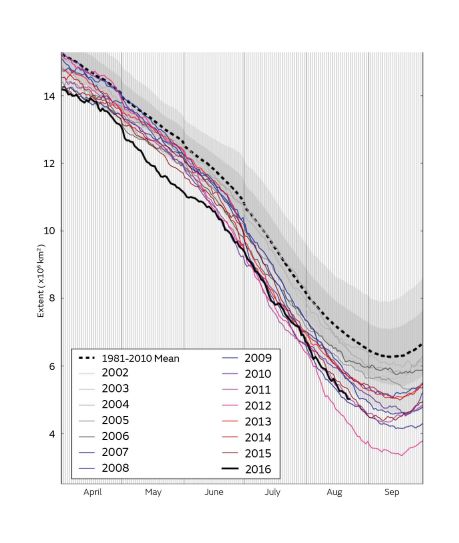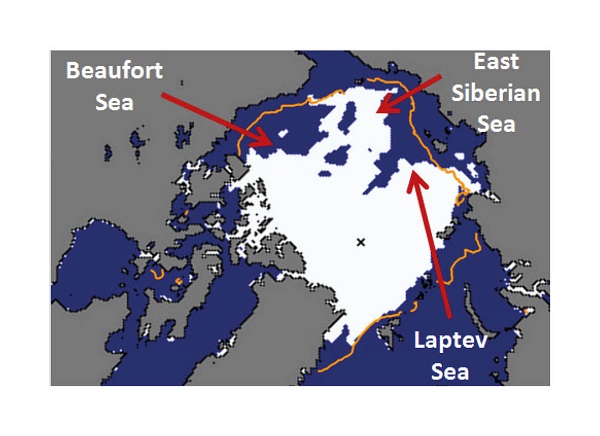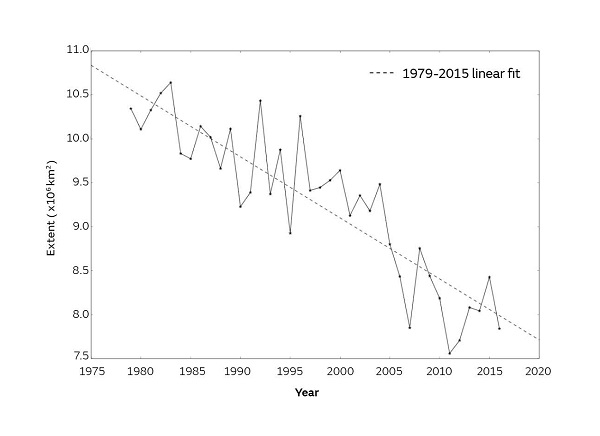Current Arctic sea ice extent in June 2016
Research news article published in June 2016.
Extent was 1.83 million square km below the 1981-2010 average for this date and 0.72 million square km above the record low for the time of year, which occurred in 2012.
Daily Arctic sea ice extent 2002-2016

Figure 1:Daily Arctic sea ice extent for 2016, compared with recent years, and the 1981-2010 average with +/- 1 and 2 standard deviation intervals indicated by the shaded areas. Data source: NSIDC
Extent is currently particularly low in the Beaufort Sea north of Alaska (Figure 2). There are large areas of sparse, diffuse ice in the Laptev and East Siberian seas.
These conditions are likely to be associated with cyclonic, stormy weather, which tends to disperse sea ice and has been prevalent over the Arctic Ocean since early July.
Arctic Sea ice extent on 17 August 2016

Figure 2:Arctic Sea ice extent on 17 August 2016, with 1981-2010 extent for this date indicated in orange. Underlying map and data courtesy of NSIDC.
July 2016 in context
The average July Arctic sea ice extent was 7.84 million square km - the third lowest July extent since satellite records began in 1979.
This July's extent was 1.63 million square km below the 1981-2010 average and 0.15 million square km below the 1979-2015 linear trend (Figure 3).
The average rate of ice extent loss for July was 83,800 square km per day, slightly below the 1981-2010 average of 86,800 square km per day.
July average Arctic sea ice extent

Figure 3:July average Arctic sea ice extent according to Met Office Hadley Centre Sea Ice and Sea Surface Temperature (HadISST) 1.2 dataset (Rayner et al, 2013)
Outlook for September 2016
A number of projections of this year's seasonal minimum (September) ice extent are displayed in Figure 4, and described below:
- Predictions of mean September extent from the Sea Ice Prediction Network (SIPN) Sea Ice Outlook, range from 3.7 to 5.2 million square km. Based on 39 predictions and a variety of methods from centres around the world the median estimate is 4.4 million square km, slightly higher than the 4.28 in last month's SIPN prediction. The median, inter-quartile range and max/min predictions are shown on the right-hand-side of Figure 4.
- Other statistical predictions based on an extrapolation of the linear trend for the entire satellite period from 1979-2015 (black) and over the most recent 15 years (red) suggest a mean September sea ice extent of 4.58 (± 1.11) and 4.10 (± 1.13) million square km respectively.
- There is a reasonable relationship between mean September ice extent and the extent for 3 - 17 August. Applying simple statistical methods to these values predicts a September mean extent of 4.35 (± 0.46) million square km.
While at this stage of the melt season a new record low September Arctic sea ice extent appears quite unlikely, the minimum is very likely to fall below the long-term linear trend, consistent with the observed long-term decline in Arctic summer sea ice.
September median Arctic sea ice extent 1979 - 2016

Figure 4:September median Arctic sea ice extent since satellite records began in 1979 from the HadISST1.2 dataset (Rayner et al., 2013). September 2016 predictions from the SIPN Sea Ice Outlook predictions and statistical estimates are included. For the statistical estimates, error bars represent twice the standard deviation of September mean ice extent about the trend lines with respect to which the estimates are taken. The Arctic Sea Ice Outlook is shown as a boxplot indicating range, median and quartiles of the 39 estimates submitted.
References
Rayner, N. A.; Parker, D. E.; Horton, E. B.; Folland, C. K.; Alexander, L. V.; Rowell, D. P.; Kent, E. C.; Kaplan, A. (2003) Global analyses of sea surface temperature, sea ice, and night marine air temperature since the late nineteenth century J. Geophys. Res. Vol. 108, No. D14, 4407 10.1029/2002JD002670
Related documents
Current Arctic sea ice extent report - August 2016





